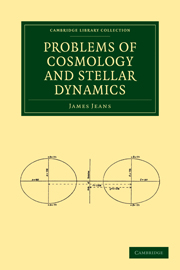Book contents
- Frontmatter
- Preface
- Contents
- I Introductory Chapter
- II General Dynamical Principles
- III Ellipsoidal Configurations of Equilibrium
- IV The Gravitational Potential of a Distorted Ellipsoid
- V Pear-shaped Configurations of Equilibrium
- VI Motion when there are no Stable Configurations of Equilibrium
- VII The Motion of Compressible and Non-homogeneous Masses
- VIII The Evolution of Gaseous Masses
- IX The Evolution of Rotating Nebulae
- X The Evolution of Star-Clusters
- XI The Evolution of Binary and Multiple Stars
- XII The Origin and Evolution of the Solar System
- Index
- Plate section
- Frontmatter
- Preface
- Contents
- I Introductory Chapter
- II General Dynamical Principles
- III Ellipsoidal Configurations of Equilibrium
- IV The Gravitational Potential of a Distorted Ellipsoid
- V Pear-shaped Configurations of Equilibrium
- VI Motion when there are no Stable Configurations of Equilibrium
- VII The Motion of Compressible and Non-homogeneous Masses
- VIII The Evolution of Gaseous Masses
- IX The Evolution of Rotating Nebulae
- X The Evolution of Star-Clusters
- XI The Evolution of Binary and Multiple Stars
- XII The Origin and Evolution of the Solar System
- Index
- Plate section
Summary
The present essay is primarily an attempt to follow up a line of research initiated by Laplace and Maclaurin, and extended in various directions by Roche, Lord Kelvin, Jacobi, Poincaré and Sir G. Darwin. Within two years of the close of his life, Darwin remarked that the way to further progress in cosmogony was blocked by our ignorance of the figures of equilibrium of rotating gaseous masses. He wrote as follows (Darwin and Modern Science, p. 563, and Tides, 3rd edition, p. 401):
“As we have seen, the study of the forms of equilibrium of rotating liquids is almost complete, and a good beginning has been made in the investigation of the equilibrium of gaseous stars, but much more remains to be discovered.”
“As a beginning we should like to know how a moderate degree of compressibility would alter the results for liquid, and…to understand more as to the manner in which rotation affects the equilibrium and stability of rotating gas. The field for the mathematician is a wide one, and in proportion as the very arduous exploration of that field is attained, so will our knowledge of the processes of cosmical evolution increase….
“Human life is too short to permit us to watch the leisurely procedure of cosmical evolution, but the celestial museum contains so many exhibits that it may become possible, by the aid of theory, to piece together bit by bit the processes through which stars pass in the course of their evolution.”
- Type
- Chapter
- Information
- Problems of Cosmology and Stellar Dynamics , pp. ix - xiPublisher: Cambridge University PressPrint publication year: 2009First published in: 1919

